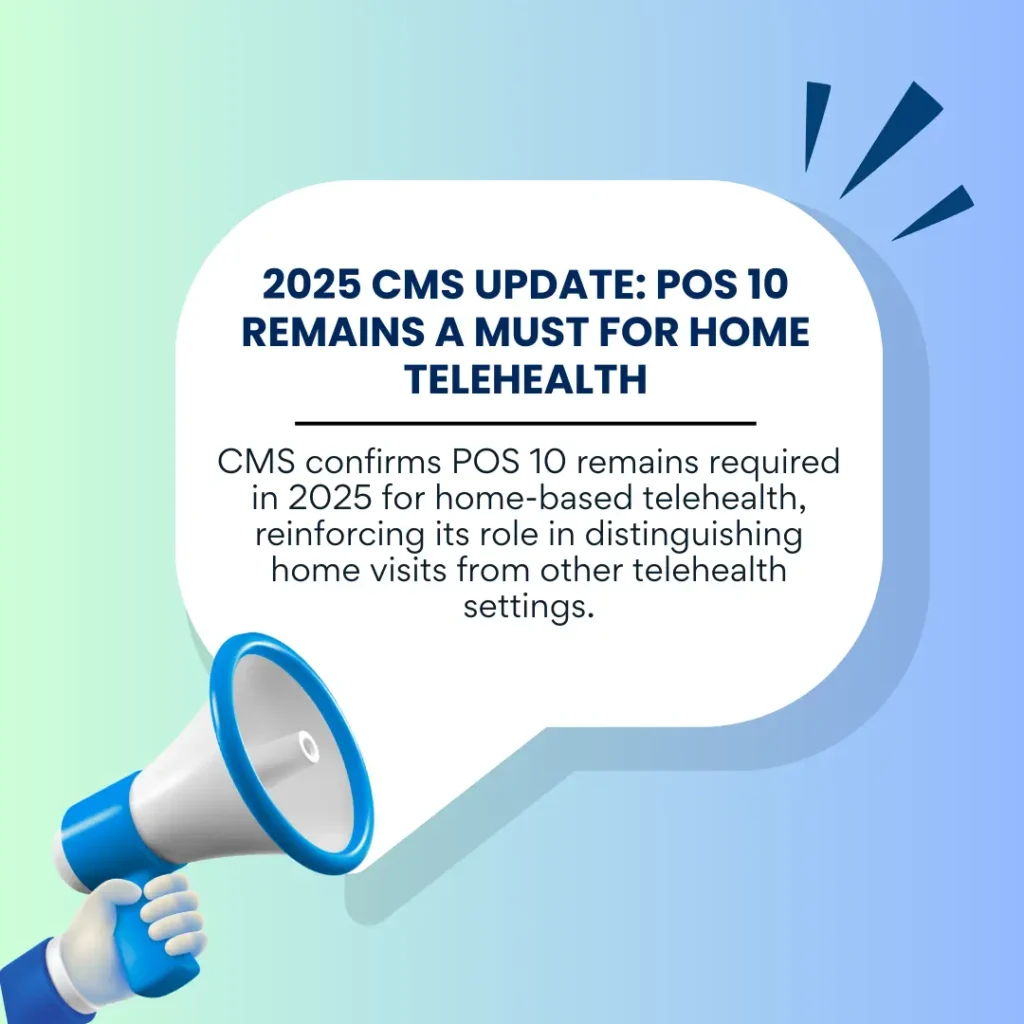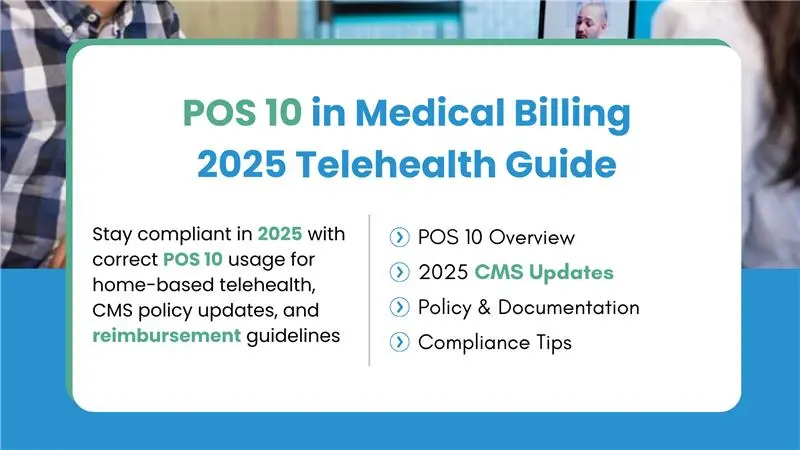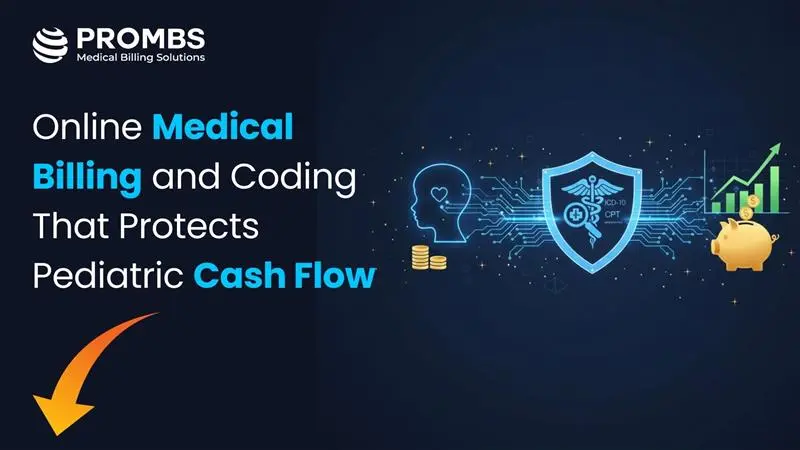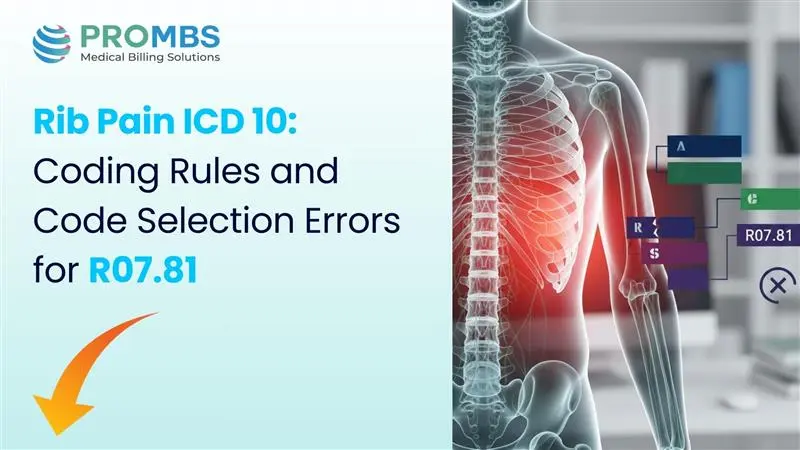In medical billing, accuracy begins long before CPT® and ICD-10 codes are applied. The Place of Service (POS) code, is a two-digit code that indicates where a healthcare service was provided is one of the most overlooked yet critical data points in claim submission. POS codes help payers determine whether the service location is eligible for reimbursement and which payment rules apply.
For telehealth and remote care, the correct POS code is not just an administrative detail, it can directly impact payment amounts, claim acceptance, and compliance with payer policies. One of the most important telehealth-related POS codes is POS 10, which specifically designates services provided via telehealth to a patient in their home.
What is POS 10 in Medical Billing?
In medical billing, POS 10 is the code used to indicate that a service was delivered through telecommunication technology while the patient was physically located in their home.
This code allows payers to differentiate between telehealth visits that occur in a patient’s private residence and those conducted from other locations such as clinics, hospitals, or skilled nursing facilities.
POS 10 became mandatory for many telehealth claims after CMS updates in 2022, and as of 2025, it remains a key compliance requirement for Medicare, Medicaid, and most commercial insurers. Using this code correctly ensures accurate reimbursement, prevents downcoding, and reduces the risk of claim denials or post-payment audits.
POS 10 Definition (Updated for 2025)
| POS Code | Location Name | Detailed Description |
|---|---|---|
| 10 | Telehealth – Patient’s Home | Used when a healthcare service is delivered via telecommunication technology while the patient is physically at home. “Home” refers to a private residence (permanent or temporary) that is not a hospital, clinic, or other institutional facility. |
Importance of POS 10 in Today’s Healthcare
- Accurate Reimbursement: Payers use POS 10 to distinguish home-based telehealth encounters from other telehealth locations, ensuring claims are processed under the correct reimbursement tier.
- Policy Compliance: Using POS 10 aligns claims with Centers for Medicare & Medicaid Services (CMS) and commercial payer rules, reducing the risk of audits and post-payment recoupments.
- Data Analytics: Proper POS coding helps practices track telehealth utilization, identify patient access trends, and forecast future service demand.

Recent CMS Announcement on POS 10 (2025 Updates)
In the 2025 Medicare Physician Fee Schedule Final Rule, the Centers for Medicare & Medicaid Services (CMS) confirmed that POS 10 will remain an active and required code for telehealth services delivered to patients in their homes. This decision reinforces the code’s role in differentiating home-based telehealth from other remote care settings.
Key 2025 Updates to POS 10 Usage:
In the 2025 Medicare Physician Fee Schedule Final Rule, the Centers for Medicare & Medicaid Services (CMS) confirmed that POS 10 will remain an active and required code for telehealth services delivered to patients in their homes. This decision reinforces the code’s role in differentiating home-based telehealth from other remote care settings.
1- POS 10 Maintained for Home Telehealth
- CMS will continue requiring POS code 10 for telehealth encounters when the patient is located in their home at the time of service.
2. Permanent Expansion of Audio-Only Telehealth
- Providers may use two-way, real-time audio-only communication for home-based telehealth when audio-video is possible but the patient cannot or will not use it.
- Applies to all eligible telehealth services, including mental and behavioral health.
3. Medicare & Payer Requirements for Audio-Only
- Standard Modality: Audio-video is preferred; audio-only allowed only when the patient is unable or unwilling to use video.
- Billing: Append modifier 93 for audio-only claims.
- Documentation: Record that audio-video was available but not used, and state the reason (e.g., no device, poor internet, patient declined).
- Consent: For mental/behavioral health, audio-only is permanently permitted, but patient consent must be documented.
4. Non-Facility Payment Rate Maintained
Claims billed with POS 10 will continue to be reimbursed at the non-facility rate, equivalent to in-person visit payment levels.
5. Return of Geographic Restrictions
- Coverage will again be limited to patients in:
- Health Professional Shortage Areas (HPSAs)
- Rural census tracts
- Counties outside Metropolitan Statistical Areas (MSAs)
- Exceptions apply for certain conditions and mental health services.
Note: Mental and behavioral health telehealth services remain permanently exempt from geographic and originating site restrictions, meaning they can be provided from a patient’s home regardless of location.
6. Expanded Practitioner Eligibility
- CMS is broadening the list of practitioners authorized to furnish telehealth services from the patient’s home.
- Includes services provided by Federally Qualified Health Centers (FQHCs) and Rural Health Clinics (RHCs).
7. Audio-Only Allowance for Mental Health
The policy allowing audio-only technology for behavioral and mental health telehealth when the patient is at home has been extended.
8. Billing Codes Guidance
- Telehealth visits from the home should continue to be billed using in-person E/M CPT codes (99202–99215).
- Do not use the CPT telemedicine code range (98000–98015)."
POS 10 vs. POS 11 – Quick Reference Table
| POS Code | Location Type | Typical Use Case | Reimbursement Impact |
|---|---|---|---|
| 10 | Telehealth at Home | Patient connects from their home via audio & video | Telehealth-specific rates; may qualify for parity payment |
| 11 | Office | In-person visit at provider’s office | Standard office visit reimbursement |
Policy Outline for Using POS 10
In 2025, a Policy Outline for POS 10 serves as a standardized guide for providers and billing staff to ensure correct use of the code for telehealth services delivered to patients in their homes, aligning with CMS regulations, maintaining accurate documentation, meeting technology and location requirements, and safeguarding reimbursement at the non-facility rate while minimizing claim denials and audit risks.
I. Purpose
- Ensure accurate billing and compliance with CMS and Medicare telehealth regulations.
- Facilitate proper delivery and reimbursement of healthcare services provided via telecommunication technology when the patient is located in their home.
II. Scope
- Applies to all practitioners and billing staff responsible for coding, documenting, and submitting telehealth claims.
- Relevant for all payers but especially for Medicare, which enforces strict POS 10 requirements.
III. Definitions
- POS 10: Designates telehealth services provided while the patient is physically located at home.
- Telehealth: Healthcare services delivered through telecommunications technology when the patient and provider are not physically in the same location.
IV. Procedures
A. Determining Appropriate POS Code
- Always use POS 10 for telehealth services when the patient is in their home.
- Use POS 02 when the telehealth encounter occurs in a location other than the home (e.g., workplace, clinic).
B. Billing and Reimbursement
- Claims with POS 10 are reimbursed at the non-facility payment rate, equivalent to in-person visits.
- Confirm current payment rates through the Medicare Physician Fee Schedule Lookup Tool before claim submission.
C. Technology Requirements
- Audio-video capability is preferred; audio-only is allowed for certain services if the provider can technically furnish video but the patient cannot or declines to use it.
- Follow CMS-approved telehealth technology standards for security and quality.
D. Provider Location and Address
- Through the end of 2025, providers may continue using their enrolled practice location instead of their home address for Medicare telehealth services provided from their home.
E. Patient Location
- Both provider and patient must be located in the U.S. or its territories during the encounter.
V. Compliance and Training
- Maintain updated knowledge of CMS guidelines, payer-specific telehealth rules, and POS code policies.
- Train all telehealth-related staff on correct POS usage, documentation, and billing workflows.
- Ensure compliance with HIPAA and any 2025 data privacy regulations.
VI. Review and Updates
- Review this policy annually or when CMS or payer rules change.
- Update internal telehealth workflows and EHR prompts to reflect the latest regulatory requirements.
Eligibility Requirements:
- Patient must be physically located in their home at the time of service.
- Encounter must meet the definition of a telehealth visit (both audio & video for Medicare; audio-only in limited approved scenarios).
Documentation Requirements:
- Mode of communication (e.g., secure video platform)
- Date and start/end time of encounter
- Patient’s location at the time of service
- Clinical notes sufficient to support medical necessity
- When billing for audio-only telehealth, document patient consent for audio-only delivery and the reason video was not used, per CMS compliance rules.
Payer-Specific Variations:
- Medicare: POS 10 + modifier 95 for synchronous telehealth
- Commercial Insurers: Some accept POS 10 without modifier 95 if EHR flags telehealth location; however, this is plan-specific. Best practice is to submit modifier 95 unless the payer’s policy explicitly excludes it to avoid claim denials or processing delays. Some commercial payers may require modifier FQ or FR in addition to 95 for audio-only mental health telehealth claims verify in payer policy.
- Medicaid: State-specific rules, some require additional telehealth attestations
Risks of Incorrect POS Code Usage:
- Overpayment Recoupment: If a payer determines the location was misclassified, reimbursement can be reclaimed months later.
- Denials: Claims can be denied outright for invalid POS/modifier combinations.
- Fraud Allegations: Repeated misreporting of POS could be interpreted as intentional misrepresentation.
Best Practices to Avoid Compliance Issues:
- Build EHR logic checks that prompt coders to confirm patient location for telehealth visits.
- Conduct monthly internal audits of telehealth claims to ensure POS codes align with encounter notes.
- Maintain audit-ready documentation with time stamps, platform logs, and patient attestations.
Different Telehealth Places of Service
| POS Code | Location Name | Description |
|---|---|---|
| 01 | Pharmacy | A location where medications, medical supplies, and related healthcare items are dispensed or sold directly to patients. |
| 02 | Telehealth – Other Than Patient’s Home | Telehealth services provided when the patient is not located in their home (e.g., at work, in a clinic). Uses telecommunication technology for delivery. |
| 03 | School | An educational facility where health services are provided within the school setting. |
| 04 | Homeless Shelter | A temporary housing facility primarily for homeless individuals or families, where healthcare services may also be delivered. |
| 05 | Indian Health Service – Free-Standing Facility | A non-hospital facility owned and operated by the Indian Health Service, providing diagnostic, therapeutic, and rehabilitative services to American Indians and Alaska Natives. |
| 06 | Indian Health Service – Provider-Based Facility | A hospital-affiliated facility operated by the Indian Health Service, offering inpatient or outpatient diagnostic, therapeutic, and rehabilitative services for American Indians and Alaska Natives. |
| 07 | Tribal 638 Free-Standing Facility | A non-hospital facility operated by a federally recognized tribe or tribal organization under a 638 agreement, providing healthcare services to tribal members. |
| 08 | Tribal 638 Provider-Based Facility | A hospital-affiliated facility operated by a federally recognized tribe or tribal organization under a 638 agreement, offering inpatient or outpatient healthcare services to tribal members. |
| 09 | Prison / Correctional Facility | A facility maintained by federal, state, or local authorities for the confinement or rehabilitation of criminal offenders, where healthcare services may be provided. |
| 10 | Telehealth – Patient’s Home | Telehealth services provided when the patient is located in their private residence, using audio-video or approved audio-only technology, and not in a hospital, clinic, or institutional setting. |
| 11 | Office | A non-hospital outpatient location, such as a physician’s office or community clinic, where examinations, diagnosis, and treatment are routinely provided. |
Conclusion
POS 10 is more than just a telehealth location code, it’s a compliance safeguard and a revenue protection tool. As healthcare continues to evolve toward hybrid and home-based models, the ability to correctly apply POS 10 will directly influence reimbursement accuracy and audit risk exposure.
By aligning with CMS definitions, understanding the distinctions from POS 11 and other related codes, and maintaining airtight documentation, providers can ensure clean claims, faster payments, and reduced compliance headaches.



